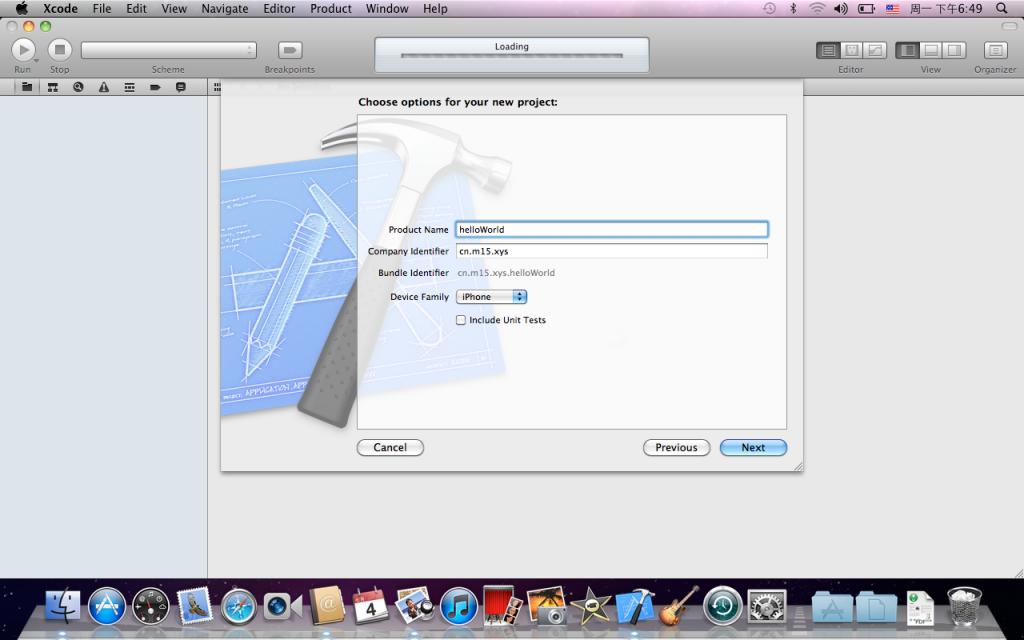Objective-C 基础语法详解
如果想从事iphone开发的话 Objective-C 这门语言就不得不学会 我们都知道C语言是没有面向对象的 而Object-C 则是ANSI C 的一个严格超集 它是具有面向对象的特性的 由于IPHONE 的成功 让这门语言现在非常的火热 今天笔者为大家介绍一下在xcode中 使用Objective-C 的基本语法。
1.打开mac系统中强大的Xcode软件 单击Create a new Xcode project 创建一个Xcode项目。

2. 选择“View-based Application” 因为只是介绍基本语法 所以 “View-based Application” 已经够用了 。 选择完后 点击Next 。

3.输入相应的信息后点击Next。
Product Name: 指产品名称 ,可以随意命名。
Company Identifier: 公司标识符,一般命名规则为 “com.公司名”
Bundle Identifier: 指包标识符,用于唯一标识应用程序,默认会根据公司标识符和产品名来组合生成
Device Family: 指该应用支持的设备类型,共三个选项:iPhone、iPad、Universal(即iPhone、iPad通用)
Include Unite Tests: 是否包含单元测试代码模板,如果勾选,Xcode会帮助生成单元测试代码模板

这样 我们的第一个项目就创建好了,接下来开始为大家介绍 Objective-C 的语法
在项目视图中 打开 helloWorldViewController.m文件 找到 - (void)viewDidLoad 方法 (这个方法每次启动程序都会调用 )
学过C++的朋友应该都知道 新写一个类会有 一个.h 声明类的变量 方法等 .cpp 用来实现方法 Objective-C 则也类似C++ .h 声明类的变量 方法 .m 用来实现方法
在c语言中 我们在控制台输出信息是用printf() Java语言则是 System.out.println() 而Objective-C 则是用 NSLog();
打开控制台的快捷键为 command + shift + R

-
-
-
-
-
-
-
-
-
#import"helloWorldViewController.h"
-
#import"MyClass.h"//导入新写的类
-
-
@implementationhelloWorldViewController
-
-
-(void)dealloc
-
{
-
[superdealloc];
-
-
}
-
-
-(void)didReceiveMemoryWarning
-
{
-
-
[superdidReceiveMemoryWarning];
-
-
-
}
-
-
#pragmamark-Viewlifecycle
-
-
-
-
-
nib.
-
-(void)viewDidLoad
-
{
-
[superviewDidLoad];
-
-
-
NSLog(@"onlyloghelloworld");
-
-
-
NSString*str;
-
NSString*str1=@"plusA";
-
NSString*str2=@"+";
-
NSString*str3=@"plusB";
-
-
str=[NSStringstringWithFormat:@"%@%@%@",str1,str2,str3];
-
-
NSLog(@"stringplus%@",str);
-
-
[selfputString:@"passstring"];
-
-
MyClass*myclass=[[MyClassalloc]init];
-
-
[myclassputclass:@"passclassstring"];
-
-
[MyClassstaticPutClass:@"staticpassclassstring"];
-
}
-
-
-
-(void)viewDidUnload
-
{
-
[superviewDidUnload];
-
-
-
}
-
-
-(BOOL)shouldAutorotateToInterfaceOrientation:(UIInterfaceOrientation)interfaceOrientation
-
{
-
-
return(interfaceOrientation==UIInterfaceOrientationPortrait);
-
}
-
-
-
-(void)putString:(NSString*)str
-
{
-
NSLog(@"%@",str);
-
}
-
-
-
@end
//这个类的声明
-
#import<UIKit/UIKit.h>
-
-
@interfacehelloWorldViewController:UIViewController{
-
-
}
-
-
-(void)putString:(NSString*)str;
-
-
@end
MyClass类的实现
-
#import"MyClass.h"
-
-
-
@implementationMyClass
-
-
-
-(void)putclass:(NSString*)str
-
{
-
NSLog(@"%@",str);
-
}
-
-
-
+(void)staticPutClass:(NSString*)str{
-
NSLog(@"%@",str);
-
}
-
@end
MyClass类的声明
-
#import<Foundation/Foundation.h>
-
-
-
@interfaceMyClass:NSObject{
-
-
}
-
-(void)putclass:(NSString*)str;
-
-
+(void)staticPutClass:(NSString*)str;
-
@end
这样Objective-C 基本的语法就给大家介绍完了, 希望有兴趣的朋友可以和我一起讨论 我们可以一起进步。
分享到:















相关推荐
Objective-C 基础语法 Objective-C 基础语法
Objective-C 基础语法学习项目
这是一个基于Objective-C语言的基础案例集 旨在用于给初学者快速了解Objective-C语言的语法 .zip
这是一个基于Objective-C语言的基础案例集。旨在用于给初学者快速了解Objective-C语言的语法。.zip
这意味着Objective-C语言不仅需要一个编译器,同时也需要一个运行时系统来执行编译好的代码。这儿的运行时系统扮演的角色类似于Objective-C语言的操作系统,Objective-C基于该系统来工作。本文档将具体介绍NSObject类...
中文名: Objective-C基础教程 作者: Mark Dalrymple Scott Knaster译者: 高朝勤 杨越 刘霞图书 分类: 软件 资源格式: PDF 版本: 扫描版 出版社: 人民邮电出版社 书号: ISBN: 9787115208774 发行时间: 2009...
Objective-C基础教程:1天玩转Objective-C语法
Objective-C的语法与Cocoa框架.pdf,挺不错的教程
帮助C++开发者,快速学习Objective-C语言核心语法。 一个非常实用的帮助文档
本书结合理论知识与示例程序,全面而系统地讲述Objective-C编程的相关内容,包括Objective-C在C的基础上引入的特性和Cocoa工具包的功能及其中的框架,以及继承、复合、源文件组织等众多重要的面向对象编程技术。...
Objective-C基础教程(入门教程).pdf
这意味着Objective-C语言不仅需要一个编译器,还需要一个运行时系统来执行编译的代码。Runtime系统是一种用于Objective-C语言的操作系统,它使OC语言工作起来。 Runtime的核心是在运行时动态操作类和消息分发给...
希望这个简单的Objective-C语言教程能够为你提供一个入门的起点。Objective-C是一种面向对象的编程语言,广泛应用于Mac OS和iOS开发。通过学习Objective-C的基本语法、类和对象、控制流程和方法等内容,你将能够编写...
Objective-C 是一种通用、面向对象的编程语言,广泛应用于 macOS 和 iOS 等苹果平台的开发中。它是 C 语言的超集,结合了 Smalltalk 式的消息传递机制和 C++ 的特性。Objective-C 是苹果公司采用的主要编程语言之一...
本书结合理论知识与示例程序,全面而系统地讲述Objective-C编程的相关内容,包括Objective-C在C的基础上引入的特性和Cocoa工具包的功能及其中的框架,以及继承、复合、源文件组织等众多重要的面向对象编程技术。...
《objective-c程序设计》通过大量的实例系统地介绍了objective-c语言的基本概念、语法规则、框架、类库及开发环境。读者在阅读《objective-c程序设计》后,可以掌握objective-c语言的基本内容,并进行实际的iphone/...
资源名称:Objective-C基础教程(第2版) 资源截图在: 资源太大,传百度网盘了,链接在附件中,有需要的同学自取。
《Objective-C基础教程》结合理论知识与示例程序,全面而系统地讲述Objective-C编程的相关内容,包括Objective-C在C的基础上引入的特性和Cocoa工具包的功能及其中的框架,以及继承、复合、源文件组织等众多重要的...
《Objective-C基础教程》全面而系统地讲述Objective-C语言的基础知识和面向对象编程的重要概念,结合实例介绍了Cocoa工具包的优秀特性和其中的框架,以及继承、复合、源文件组织、内存管理、对象初始化和类别创建等...